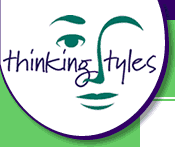 |
| |
|
The Thinking Styles Report gives a graphic and verbal representation
of your own Personal Profile. There are no right or wrong
profiles.
This is a shortened example of an individual's profile from
a report with a possible interpretation.
|
| |
 |
| |
| The above profile suggests that the person has a high preference
for Visual and Kinaesthetic thinking, a moderate preference
for Auditory processing and a low preference for Digital thinking.
It also shows that there are some elements of both Auditory
and Digital processing which they dislike doing. (To understand
which of the surface traits they have expressed a dislike for,
you will need to examine their responses to the relevant statements
in the Thinking Styles Questionnaire). |
| |
 |
| |
|
The above profile suggests that this person has a very strong
dislike of Self behaviours and a high preference for Others
thinking. Potentially, if they never 'put themselves first'
this could leave them permanently exhausted! Their profile
also suggests that they have a high preference for Internally
Referenced thinking and that there are some elements of External
thinking which they dislike using. If this means that they
tend to ignore feedback from others and always believe that
they are 'right', potentially they could come across as being
very arrogant, although their high Others preference may help
to mediate this.
Although they have a low preference for Matching thinking,
there are elements of Matching behaviours which they dislike
doing and they have a high preference for Mismatching processing.
Potentially, this could lead to them being perceived as 'argumentative',
particularly if they are prepared to challenge others (which
is very likely, given their high Internal score). Although
they haven't disagreed with any statements relating to either
Collaborative or Competitive processing, their scores suggest
a low preference for Collaborative thinking and a moderate
preference for Competitive thinking. Behaviourally, I would
probably expect to see both Competitive and Collaborative
behaviours displayed in their working environment.
|
| |
 |
| |
| You will notice that there is no explanation for the Task
Focus dimensions here. This is because we have used this as
a competition for those of you who would like to "have
a go". If you would like to enter our competition to win
a copy of the book "Thinking Styles-Relationship Strategies
that work", then click here. |
| |
|
The Report
In the first part of the report you will find your Personal
Summaries and the dimension definitions. In the second part
of your report you will find more detailed descriptions of
each Thinking Style.
These are written in a consistent format. We have included
those behaviours, filters and language patterns identified
through our questionnaires as being the most relevant to each
style. We have also included some of those behaviours, language
patterns and cognitive filters which are likely to be associated
with each style. For each dimension, there is an explanation
on how to manage and motivate people who score highly against
the dimension, whether they are working with you, are working
for you or are your manager. Finally we have designed some
exercises to increase your flexibility for each Thinking Style.
The exercises are designed for people who have a low preference
or flexibility for the dimension should they choose to increase
their flexibility. Those people who already score quite highly
may want to do the exercises just for fun! Click
here.
|
| |
Competition
Have a go at our free competition to win a copy of the book
"Thinking
Styles - Relationship Strategies that work". |
| |
| Read the questions and e-mail us with your
ideas: |
| • |
How would you describe the above Task
Focus profile? |
| • |
Using the dimension definitions, what behavioural characteristics
might you expect the individual to display? |
| • |
What would you suggest that their cognitive strengths
and potential weaknesses might be at work relating to
these Task Focus dimensions? |
|
| |
|
This is an exercise we use on our Licensing
Programme. Every week we will be selecting a winner
who will receive a copy of the book, dedicated to them and
signed by the author, Fiona Beddoes-Jones. The competition
is open to all and will be reviewed weekly.
Tip: We would suggest that you print off the Dimension
Definitions and the other Profile pages to help you, then
e-mail
us with your comments on what the Task Focus profile
suggests in behavioural terms.
|
| |
 |
| |


